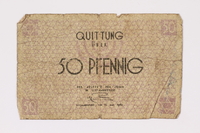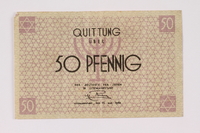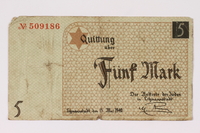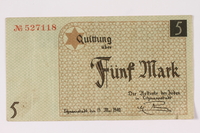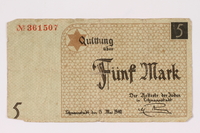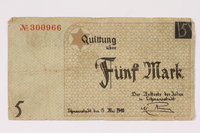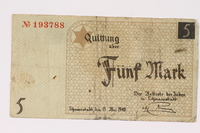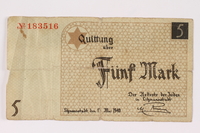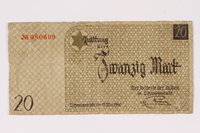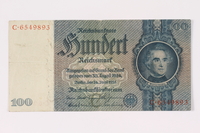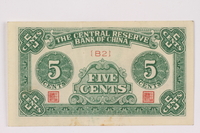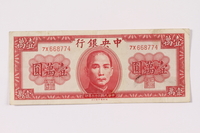Overview
- Credit Line
- United States Holocaust Memorial Museum Collection, Gift of Leo Arnfeld
Physical Details
- Classification
-
Exchange Media
- Category
-
Money
- Object Type
-
Scrip (aat)
- Dimensions
- overall: Height: 2.870 inches (7.29 cm) | Width: 5.120 inches (13.005 cm)
- Materials
- overall : paper, ink
Rights & Restrictions
- Conditions on Access
- No restrictions on access
- Conditions on Use
- No restrictions on use
Administrative Notes
- Legal Status
- Permanent Collection
- Provenance
- The scrip was donated to the United States Holocaust Memorial Museum in 1990 by Leo Arnfeld.
- Record last modified:
- 2022-07-28 18:21:18
- This page:
- https://collections.ushmm.org/search/catalog/irn2719
Download & Licensing
In-Person Research
- By Appointment
- Request 21 Days in Advance of Visit
- Plan a Research Visit
- Request to See This Object
Contact Us
Also in Leo Arnfeld collection
The Leo Arnfeld collection consists of biographical materials, correspondence, photographs, and a satirical pamphlet documenting the Arnfeld family in Warsaw, Sara and Leo Arnfeld in the Warsaw ghetto, Chaim Arnfeld in Vilnius, Kobe, and Shanghai, and Leo Arnfeld’s postwar life in Munich. The collection also includes cosmetics and pharmaceutical labels and sample from Chaim Arnfeld’s pharmacy in Warsaw as well as German and Chinese currency, Łódź ghetto scrip, and Japanese occupation currency.
Date: 1920-1958
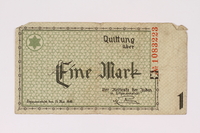
Łódź (Litzmannstadt) ghetto scrip, 1 mark note
Object
1 (eine) mark receipt issued in the Łódź ghetto in Poland in May 1940. Nazi Germany occupied Poland on September 1, 1939; Łódź was renamed Litzmannstadt and annexed to the German Reich. In February, the Germans forcibly relocated the large Jewish population into a sealed ghetto. All currency was confiscated in exchange for Quittungen [receipts] that could be exchanged only in the ghetto. The scrip was designed by the Judenrat [Jewish Council] and includes traditional Jewish symbols. The Germans closed the ghetto in the summer of 1944 by deporting the residents to concentration camps or killing centers.
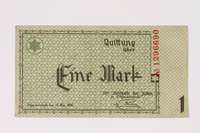
Łódź (Litzmannstadt) ghetto scrip, 1 mark note
Object
1 (eine) mark receipt issued in the Łódź ghetto in Poland in May 1940. Nazi Germany occupied Poland on September 1, 1939; Łódź was renamed Litzmannstadt and annexed to the German Reich. In February, the Germans forcibly relocated the large Jewish population into a sealed ghetto. All currency was confiscated in exchange for Quittungen [receipts] that could be exchanged only in the ghetto. The scrip was designed by the Judenrat [Jewish Council] and includes traditional Jewish symbols. The Germans closed the ghetto in the summer of 1944 by deporting the residents to concentration camps or killing centers.
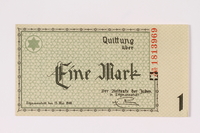
Łódź (Litzmannstadt) ghetto scrip, 1 mark note
Object
1 (eine) mark receipt issued in the Łódź ghetto in Poland in May 1940. Nazi Germany occupied Poland on September 1, 1939; Łódź was renamed Litzmannstadt and annexed to the German Reich. In February, the Germans forcibly relocated the large Jewish population into a sealed ghetto. All currency was confiscated in exchange for Quittungen [receipts] that could be exchanged only in the ghetto. The scrip was designed by the Judenrat [Jewish Council] and includes traditional Jewish symbols. The Germans closed the ghetto in the summer of 1944 by deporting the residents to concentration camps or killing centers.

Łódź (Litzmannstadt) ghetto scrip, 1 mark note
Object
1 (eine) mark receipt issued in the Łódź ghetto in Poland in May 1940. Nazi Germany occupied Poland on September 1, 1939; Łódź was renamed Litzmannstadt and annexed to the German Reich. In February, the Germans forcibly relocated the large Jewish population into a sealed ghetto. All currency was confiscated in exchange for Quittungen [receipts] that could be exchanged only in the ghetto. The scrip was designed by the Judenrat [Jewish Council] and includes traditional Jewish symbols. The Germans closed the ghetto in the summer of 1944 by deporting the residents to concentration camps or killing centers.

Łódź (Litzmannstadt) ghetto scrip, 1 mark note
Object
1 (eine) mark receipt issued in the Łódź ghetto in Poland in May 1940. Nazi Germany occupied Poland on September 1, 1939; Łódź was renamed Litzmannstadt and annexed to the German Reich. In February, the Germans forcibly relocated the large Jewish population into a sealed ghetto. All currency was confiscated in exchange for Quittungen [receipts] that could be exchanged only in the ghetto. The scrip was designed by the Judenrat [Jewish Council] and includes traditional Jewish symbols. The Germans closed the ghetto in the summer of 1944 by deporting the residents to concentration camps or killing centers.
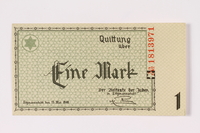
Łódź (Litzmannstadt) ghetto scrip, 1 mark note
Object
1 (eine) mark receipt issued in the Łódź ghetto in Poland in May 1940. Nazi Germany occupied Poland on September 1, 1939; Łódź was renamed Litzmannstadt and annexed to the German Reich. In February, the Germans forcibly relocated the large Jewish population into a sealed ghetto. All currency was confiscated in exchange for Quittungen [receipts] that could be exchanged only in the ghetto. The scrip was designed by the Judenrat [Jewish Council] and includes traditional Jewish symbols. The Germans closed the ghetto in the summer of 1944 by deporting the residents to concentration camps or killing centers.

Łódź (Litzmannstadt) ghetto scrip, 1 mark note
Object
1 (eine) mark receipt issued in the Łódź ghetto in Poland in May 1940. Nazi Germany occupied Poland on September 1, 1939; Łódź was renamed Litzmannstadt and annexed to the German Reich. In February, the Germans forcibly relocated the large Jewish population into a sealed ghetto. All currency was confiscated in exchange for Quittungen [receipts] that could be exchanged only in the ghetto. The scrip was designed by the Judenrat [Jewish Council] and includes traditional Jewish symbols. The Germans closed the ghetto in the summer of 1944 by deporting the residents to concentration camps or killing centers.

Łódź (Litzmannstadt) ghetto scrip, 1 mark note
Object
1 (eine) mark receipt issued in the Łódź ghetto in Poland in May 1940. Nazi Germany occupied Poland on September 1, 1939; Łódź was renamed Litzmannstadt and annexed to the German Reich. In February, the Germans forcibly relocated the large Jewish population into a sealed ghetto. All currency was confiscated in exchange for Quittungen [receipts] that could be exchanged only in the ghetto. The scrip was designed by the Judenrat [Jewish Council] and includes traditional Jewish symbols. The Germans closed the ghetto in the summer of 1944 by deporting the residents to concentration camps or killing centers.

Money
Object
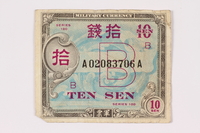
Money
Object

Money
Object

Money
Object

Leo Arnfeld papers
Document
The Leo Arnfeld papers consist of biographical materials, correspondence, photographs, and a satirical pamphlet documenting the Arnfeld family in Warsaw, Sara and Leo Arnfeld in the Warsaw ghetto, Chaim Arnfeld in Vilnius, Kobe, and Shanghai, and Leo Arnfeld’s postwar life in Munich. The collection also includes cosmetics and pharmaceutical labels and sample from Chaim Arnfeld’s pharmacy in Warsaw. Biographical materials consist of business cards, identification papers, and a prescription documenting Chaim Arnfeld’s situation and work in Shanghai. Correspondence consists primarily of letters and postcards from Sara Arnfeld to her husband in Kobe describing her experiences with Leo in the Warsaw ghetto. This series also includes two postcards from Holocaust survivor Abram Kadysiewicz in Szczecin and two empty envelopes from survivor Regina Gutrajch, who had been a neighbor of Sara’s and Leo’s in the ghetto, as well as a copy of Sara’s and Chaim’s 1938 wedding invitation. Pharmacy records include product labels and samples and a letter documenting Chaim Arnfeld’s employment. Photographs depict Leo, Chaim, and Sara Arnfeld and their family members and friends in Warsaw, the Warsaw ghetto, Vilnius, Shanghai, and Munich. This series also includes a photograph of Kanoh Ghoya, an official in the Hongkew ghetto in Shanghai. The collection includes a 1945 pamphlet, “Good-bye Mr. Ghoya,” including a series of color cartoons by F. Melchior that parodies Kanoh Ghoya, the Hongkew ghetto official in charge of distributing temporary leave passes to ghetto residents.

